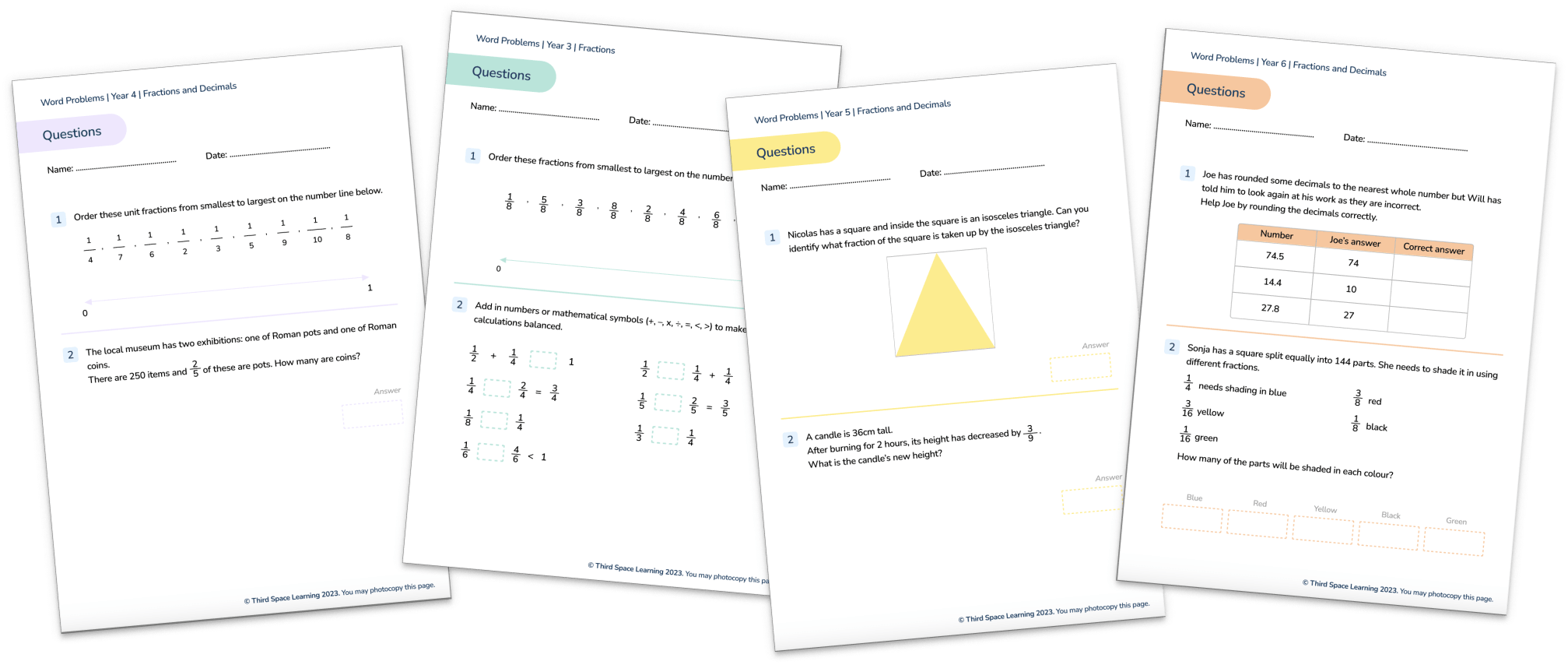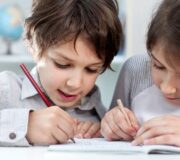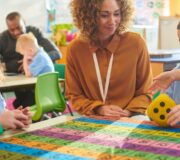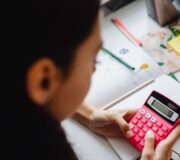25 Money Word Problems for Year 2 to Year 6 With Tips On Supporting Pupils’ Progress
Word problems with money are first introduced in the Maths Curriculum in Year 2. At this stage, children learn to recognise the different coins and the symbols for pounds and pence; find different combinations of coins and begin to solve simple addition and subtraction word problems.
As pupils progress through primary, they continue to encounter money and word problems involving money, right through to upper Key Stage 2. By Year 6 money is no longer specifically identified in the curriculum. However, pupils continue to be exposed to money word problems, through a range of mathematical concepts and word problems including: addition and subtraction word problems, division word problems, multiplication word problems decimals, fractions, percentages, ratio and algebra.
- Money word problems in the national curriculum
- Why are word problems important for children’s understanding of money
- How to teach money word problem solving in primary school
- Money word problems for year 2
- Money word problems for year 3
- Money word problems for year 4
- Money word problems for year 5
- Money word problems for year 6
- More word problems resources
When children are first introduced to money problems, it is important for them to physically have the money to hold and manipulate, to help solve the problems. As students progress through the school, there is less of a need to have the money physically in their hands. Once they have built confidence in using written calculation methods, they are able to solve more complex problems involving money.
All Kinds of Word Problems
Download this free pack of word problems covering a wide range of maths topics. Perfect for developing your class' problem solving skills!
Download Free Now!Children benefit from regular exposure to word problems, alongside any fluency work they are doing. To help you with this, we have put together a collection of 25 money word problems, which can be used with pupils from Year 2 to Year 6.
Children are also exposed to money word problems in Third Space Learning’s AI maths tutoring programmes with Skye, the AI maths tutor. Adapted to the needs of each individual students, our programmes help to build maths skills and grow confidence in our young mathematicians.
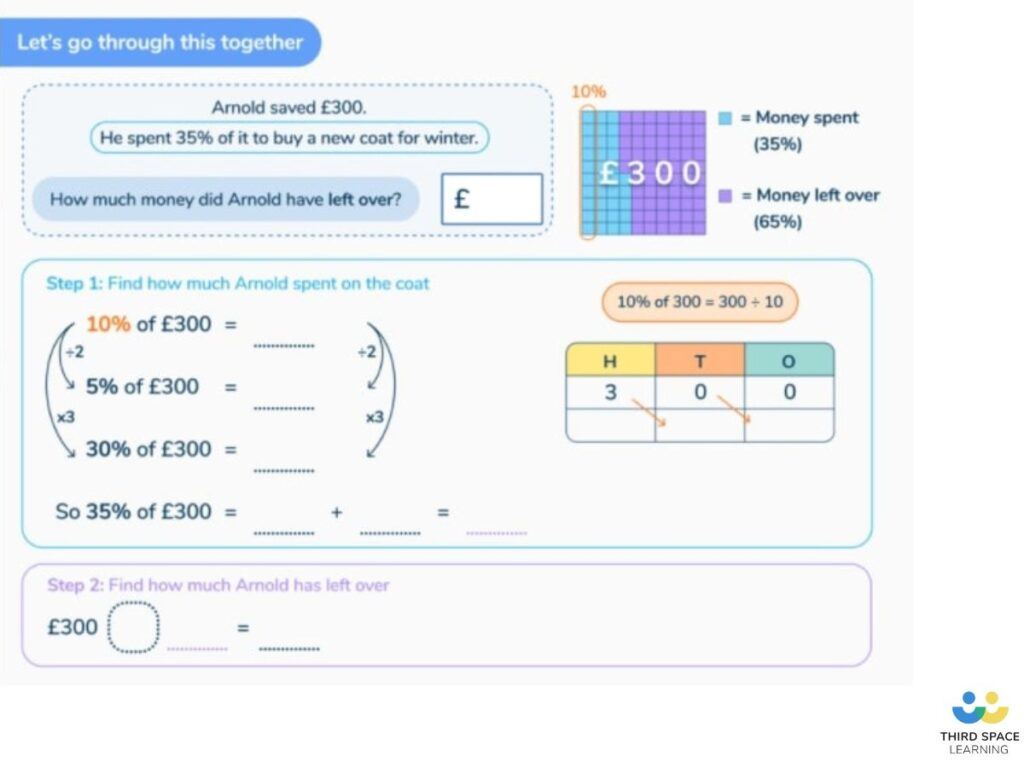
Money word problems in the national curriculum
Money word problems in Year 2
In Year 2, pupils are introduced to the different coins; learn the symbols for pounds and pence and combine amounts to make a particular value. They work on simple problems in a practical context involving addition word problems, and subtraction word problems of money of the same unit, including giving change.
Money word problems in Year 3
Pupils in Year 3 continue to build on their understanding of money and its use in a practical context. They progress from adding and subtracting money of the same unit, to working with both pounds and pence; adding and subtracting amounts and giving change. Pupils in Year 3 start to solve simple 2-step calculations, by finding totals and working out how much change would be given.
Money word problems in Year 4
In Year 4, the curriculum no longer mentions money under measures, but pupils continue to work with money through fractions and decimals. At this stage, pupils are expected to solve simple measures and money problems involving fractions and decimals to two decimal places.
Money word problems in Year 5
Pupils in Year 5 are becoming more confident with the formal written methods for the four operations and are exposed to money word problems involving all four. They also continue to build on the knowledge of fractions and decimals and are first introduced to percentages through a range of word problems.
Money word problems in Year 6
By Year 6, money is no longer explicitly mentioned in the curriculum, however pupils are exposed to word problems across a range of concepts, including: the four operations, fractions, decimals and percentage word problems, ratio word problems and algebra.

Meet Skye, the voice-based AI tutor making maths success possible for every student.
Built by teachers and maths experts, Skye uses the same pedagogy, curriculum and lesson structure as our traditional tutoring.
But, with more flexibility and a lower cost, schools can scale online maths tutoring to support every student who needs it.
Watch Skye in actionWhy are word problems important for children’s understanding of money
Word problems are essential to children’s understanding of money, because they enable students to use money in a range of contexts they will be using in real-life. Confidence with money is a key life skill and it is important children have plenty of exposure to using it in a wide range of contexts. Money problems give children the opportunity to utilise the skills they have learnt in the maths lessons and put them into context, in a situation they understand and can relate to.
How to teach money word problem solving in primary school
Pupils need to be taught the skills needed to solve word problems. It is essential they understand the importance of reading questions carefully, making sure they fully understand what is being asked. They then need to identify which calculation is required and whether there are any concrete resources or pictorial representations they can use to help them, alongside the coins, such as place value counters and bar models.
Here is an example:
An adult’s ticket to the water park costs £15.50, whilst a children’s ticket cost £9.50.
How much would it cost for 2 adults and 2 children to visit the water park and how much change would they get from £100?
How to solve:
What do you already know?
- We know that an adult ticket costs £15.50 and a child ticket costs £9.50.
- To calculate the cost of both adults, we are going to need to multiply the £15.50 by 2, or add £15.50 and £15.50.
- We will also need to do the same with the child’s ticket, costing £9.50.
- Once we have calculated the total cost of both adults and both children, we’ll need to add these answers together, to establish the total cost for the whole family.
- To calculate the amount of money from £100, we will need to subtract the total cost for the family from £100.
How can this be represented pictorially?
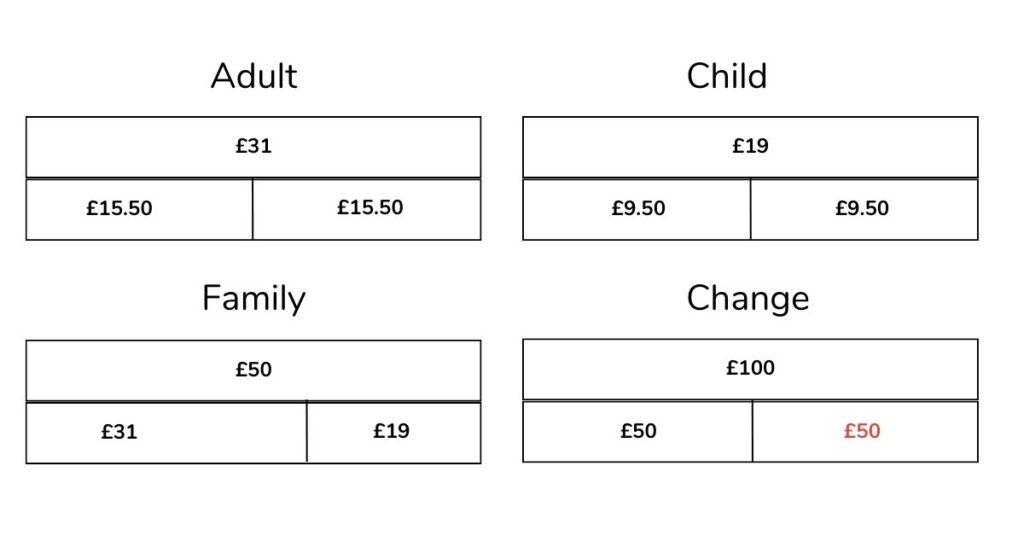
- We can draw bar models to represent the cost of the adult tickets, child tickets and the total for the family.
- We can then use the answer from the third bar model to represent finding how much change from £100.
- We can see from these bar models that there would be £50 left once the family had paid to enter the waterpark.
Money word problems for year 2
Money word problems in Year 2 require students to recognise coins and use the symbols for pounds and pence. Children solve real world problems – finding totals and calculating change when working with the same unit (pounds or pence).
Question 1
Mason buys a pen for 14p and a rubber for 8p. How much does he spend altogether?
Answer: 22p
14 + 8 = 22
Question 2
Maisie gets 20p from the tooth fairy. She already had 16p.
How much does she have now?
Answer: 36p
20 + 16 = 36
Question 3
Maisie has 3 coins.
She has 16p in total.
Which 3 coins must she have?
Answer: 10p, 5p and 1p
10 + 5 + 1 = 16
Question 4
Maryam spends 28p on a bag of sweets.
She gets 12p change.
How much did she pay for the bag of sweets?
Answer: 40p
28 + 12 = 40p
Question 5
Hamza has two 20p coins.
He buys a chocolate bar for 30p.
How much change does he get?
Answer: 10p change
20 + 20 = 40
40 – 30 = 10
Money word problems for year 3
Word problems for year 3 build upon the knowledge from year 2, solving word problems involving both pounds and pence together and calculating change. At this stage, children should be using decimal notation for amounts of money and using both formal and informal methods to add and subtract money amounts in pounds and pence.
Question 1
(Pictures of 1p, 5p, 10p, 20p, 50p and £1 coins here)
Jamie has the coins above in his wallet. If he takes out 3 coins, what is the highest amount he could take out of his wallet?
Answer: £1.70
£1 + 50p + 20p
Question 2
Noah buys 2 chocolate bars for £1.35 each and a packet of crisps for 45p.
How much does he spend altogether?
Answer: £3.15
1.35 x 2 = 2.70
2.70 + 45 = 315
Question 3
Tickets for the school fair are £1.50 for children and £2.50 for adults.
How much will it cost for family of 2 adults and 2 children to go to the fair?
Answer: £8
1.50 x 2 = 3
2.50 x 2 = 5
3 + 5 = 8
Question 4
Jackson buys 4 apples for 30p each and 2 bananas for 25p each.
How much does he spend altogether?
Answer: £1.70
30 x 4 = 120
25 x 2 = 50
120 + 50 = 170
Question 5
Amaya had £10 to spend at a carboot sale.
She bought 2 books for £1.20 each and a pack of pens for £1.50,
How much money did she have left at the end?
Answer: £6.10
Children should be able to solve each part mentally, by adding the pounds and then the pence.
1.20 +1.20 = 2.40
2.40 + 1.50 = 3.90
To work out how much change Amaya would get, children can count up from £3.90 to £10.00. They will find this easier than subtracting £3.90 from £10.00.
10.00 – 3.90 = 6.10
Money word problems for year 4
With word problems for year 4, pupils need to be able to order amounts of money, using rounding to estimate and calculate using the four operations. They also encounter money maths problems through other concepts, such as fractions.
Question 1
Sam bought a T-shirt for £18.50 and a hoodie for £24.99. How much did he spend in total?
Answer: £43.49
Show as column method: 18.50 + 24.99 = 43.49
Question 2
- Pizza: £2.99
- Burger: £2.50
- Hot dog: £1.80
- Fries: 1.25
Chloe took her best friend out to celebrate her birthday.
She bought a pizza, a burger and 2 portions of fries.
How much did she spend altogether?
Answer: £7.99
Show as column method:
2.99 + 2.50 = 5.49
1.25 x 2 = 2.50
5.59 + 2.50 = 7.99
Question 3
Mason won £500 in a competition.
He decided to give ⅕ of the prize to his sister, ⅕ to his brother and ⅕ to his parents.
How much money did he keep for himself?
Answer
£200
⅕ of 500 = 100
He gave ⅗ away and kept ⅖ for himself. ⅖ of 500 = 200
Question 4
A school paid 4p for every worksheet printed out on the photocopier
Teachers printed out 560 maths worksheets in one week.
How much did the school spend, printing out the worksheets?
Answer: £22.40
560 x 4 = 2240
2240p = £22.40
Question 5
Sara had £100 to spend on clothes.
She bought a pair of jeans for £44.50 and a top for £35.99
How much money did Sara have left?
Answer: £19.51
Show as column method:
44.50 + 35.99 = 80.49
100 – 80.49 = 19.51
Money word problems for year 5
Word problems for year 5 include the four operations, but with larger numbers than pupils were working with in Lower Key Stage 2. They are also presented to students through fraction word problems, decimal and percentages topics
Question 1
Mr Smith spends £5,999 on a car and £3,899 on a caravan.
How much does he spend altogether?
Answer: £9,898
Show as column addition:
5999 + 3899 = 9898
Question 2
Oliver is saving to buy a laptop costing £1250.
He has saved ⅖ of the money he needs. How much more does he need to save to buy the laptop?
Answer: £750
⅕ = 1250 ÷ 5 = £250
⅗ = £750
Question 3
Mason saves £9 every week, from carrying out jobs around the house.
He is saving to buy a new phone, costing £370.
How many weeks will it take him to save enough money to buy the phone?
Answer: Mason will need to save for 42 weeks
Show as bus stop division: 370 ÷ 9 = 41 r1
Question 4
Amber is at the fun fair.
Her favourite ride costs £2.75. She goes on that 5 times and buys a packet of doughnuts for £1.80.
If she had £20 to spend, how much money does she have left at the end?
Answer: £4.45
Show as column method:
2.75 x 5 = 13.75
13.75 + 1.80 = £15.55
20.00 – 15.55 = 4.45
Question 5
Jemma is calculating how much it will cost her to buy party bags for all the friends who come to her party.
Each party bag costs £3.75 and she has 9 friends coming to her party.
How much will she need to pay for the 9 party bags in total?
Answer: £33.75
Show as column multiplication: 3.75 x 9 = 33.75
Money word problems for year 6
With word problems for year 6, pupils encounter multi-step word problems and those involving larger amounts of money and cover a range of concepts, including: the 4 operations, fractions, decimals, percentages, ratio and algebra. Money word problems are often included in the KS2 reasoning SATs papers.
Question 1
Mr and Mrs Jackson are buying a new house.
The house costs £425,999 to buy and they have a deposit of £84,000 from the sale of their last house.
How much more will they have to borrow, to be able to buy the house?
Answer: £341,999
425,999 – 84,000 = 341,999
Question 2
The cost for all 90 Year 6 pupils to visit the outward bounds centre for the day is £2,430
How much does it cost per child?
Answer: £27
Show as long division:
2430 ÷ 90 = 27
Question 3
A car decreases in value by 23% in one year. If it was worth £10,000 when it was bought. How much is it worth now?
Answer: £7,700
10% of 10,000 = £1,000
20% of £10,000 = £2000
1% of £10,000 = 100
3% of £10,000 = 300
23% = 2300
10,000 – 2300 = 7,700
Question 4
Mr Lampard was budgeting for the month,
He needed to pay:
- £800 rent
- £240 council tax
- £150 for gas and electricity
- £45 for water
- £38 for internet and phone line
- £125 petrol
After tax he earns £3200 per month.
How much does he have left over for food, social activities and saving.
Answer: £1802
Total spent:
Show as column addition:
800 + 240 + 150 + 45 + 38 + 125 = 1398
3200 – 1398 = 1802
Question 5
£60 is shared between Abbie, Ben and Carly, as a ratio of 2:3:7
How much does each person get?
Answer: Abbie: £10, Ben: £15, Carly: £35
60 ÷ 12 = 5
2 x 5 = 10
3 x 5 = 15
7 x 5 = 35
More word problems resources
Looking for more word problems on a range of topics? Take a look at our collection of time word problems.
DO YOU HAVE STUDENTS WHO NEED MORE SUPPORT IN MATHS?
Skye – our AI maths tutor built by teachers – gives students personalised one-to-one lessons that address learning gaps and build confidence.
Since 2013 we’ve taught over 2 million hours of maths lessons to more than 170,000 students to help them become fluent, able mathematicians.
Explore our AI maths tutoring or find out about a primary school maths tutor for your school.



